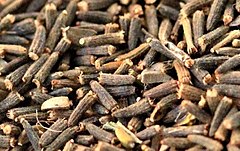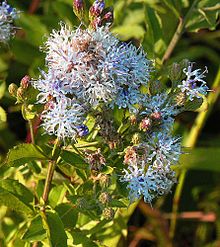Vernonia oil

|
|
| Raw material plant (noun) |
Centrapalus pauciflorus (Syn: Vernonia galamensis ) |
| origin |
Achenes (cypselas) |
| colour |
light to dark yellow |
| ingredients | |
| Oleic acid | 2-10% |
| Linoleic acid | 9-25% |
| Linolenic acid | <0.5% |
| Palmitic acid | 2-3% |
| Myristic acid | <0.6% |
| More fatty acids | 54-80% vernolic acid, 1-4% stearic acid |
| properties | |
| density | 0.905-0.973 kg / L at 25 ° C |
| viscosity | = 107-119 mPa · s at 25 ° C |
| Melting point | 2.5 ° C |
| Iodine number | 86-107.5 |
| Saponification number | 165-210 |
| Manufacturing and Consumption | |
| Most important production countries | Zimbabwe , Kenya |
Vernonia oil also ( kinka oil , vapachi oil especially for Baccharoides anthelmintica ), is a vegetable oil made from the seeds ( achenes ) of various African composites (Asteraceae); formerly Vernonia species that have now been re- taxonomized . The seeds contain approx. 23–43% fat. The main supplier today is Centrapalus pauciflorus (Syn: Vernonia galamensis ), the oil yield is also higher here.
The triglycerides of the viscous and optically active oil consist mainly of esters with vernolic acid , an unsaturated, epoxidized fatty acid . The oxirane value is approx. 3.5–4%.
The seeds of these plants show a high lipase activity in the resting state. The activity of this enzyme is evident as the vernonia oil undergoes lipolysis if the seeds are crushed prior to extraction. A special extraction technique is therefore necessary. If lipolysis is not checked, the triglycerides of the oil ( Trivernolin ) are split into the diglyceride divernolin and vernolic acid.
The oil can be obtained by cold pressing or with solvents, as well as with supercritical fluids , after the seeds are coarsely ground with dry ice and an intermediate stage with a special heating phase (tempering) takes place before the extraction, pressure-induced denaturation is also possible in order to switch off the lipase activity to inhibit. Vernonia oil can be used directly as a polymerizable monomer in the coating by means of cationic UV curing .
Vernonia oil is used for epoxies for the production of adhesives, lacquers and paints as well as industrial paints.
Individual evidence
- ^ GE Wickens, N. Haq, Peter R. Day: New Crops for Food and Industry. Chapman & Hall, 1989, ISBN 0-412-31500-9 , p. 197.
- ↑ a b c d e f g h i j Frank D. Gunstone, John L. Harwood, Fred B. Padley: The Lipid Handbook. Second Edition, Chapman & Hall, 1994, ISBN 0-412-43320-6 , p. 106.
- ↑ A. Grün , W. Halden: Analysis of fats and waxes. Second volume, Springer, 1929, ISBN 978-3-642-89318-6 , p. 165.
- ↑ a b c A. E. Thompson, DA Dierig, R. Kleiman: Characterization of Vernonia galamensis germplasm for seed oil content, fatty acid composition, seed weight, and chromosome number. In: Industrial Crops and Products. Volume 2, Issue 4, 1994, pp. 299-305, doi: 10.1016 / 0926-6690 (94) 90121-X , nal.usda.gov (PDF; 397 kB) on pubag.nal.usda.gov; accessed on November 28, 2017.
- ↑ a b Tesfaye Baye, Heiko C. Becker, Sabine v. Witzke-Ehbrecht: Vernonia galamensis, a natural source of epoxy oil: Variation in fatty acid composition of seed and leaf lipids. In: Industrial Crops and Products. Volume 21, Issue 2, 2005, pp. 257-261, doi: 10.1016 / j.indcrop.2004.04.003 .
- ↑ Vernonia species at PlantFA Database, accessed on November 28, 2017.
- ↑ a b c K. D. Carlson, WJ Schneider et al .: Vernonia galamensis Seed Oil: A New Source for Epoxy Coatings. In: New Sources of Fats and Oils. AOCS Monograph No. 9, American Oil Chemists' Society, 1981, pp. 297-318, online (PDF; 8.5 MB)
- ↑ CG Gebelein: Biotechnology and Polymers. Springer, 1991, ISBN 978-1-4613-6715-4 , p. 82.
- ↑ Reuben RK Kimwomi: The extraction and characterization of vernonia oil from Vernonia galamensis seeds and its conversion into dibasic acids and some adhesive resins. Diploma thesis, University of Nairobi, Kenya 1992, online ( page no longer available , search in web archives ) Info: The link was automatically marked as defective. Please check the link according to the instructions and then remove this notice. (PDF; 2.7 MB), from University of Nairobi Research Archive, accessed on November 28, 2017.
- ↑ Frank D. Gunstone, Fred B. Padley: Lipid Technologies and Applications. Marcel Dekker, 1997, ISBN 0-8247-9838-4 , p. 760.
- ^ Ullmann's Food and Feed. Vol. 2, Wiley, 2017, ISBN 978-3-527-33990-7 , p. 727.
- ↑ L. Ubbelohde , F. Goldschmidt: Handbook of chemistry and technology of oils and fats. Volume II, Hirzel, 1920, p. 2, archive.org .
- ^ US Congress, Office of Technology Assessment: Agricultural Commodities as Industrial Raw Materials. US Gov. Printing Office, 1991, p. 87 f, online (PDF; 2.4 MB), on hdl.handle.net, accessed on November 28, 2017.
- ↑ Vernonia galamensis at PROTA, accessed on November 28, 2017.
- ^ David L. Kaplan: Biopolymers from Renewable Resources. Springer, 1998, ISBN 978-3-642-08341-9 , p. 275, doi: 10.1007 / 978-3-662-03680-8 .
- ↑ Chemisches Zentralblatt . Volume 138, Issues 49-52, 1967, p. 285.
- ↑ CF Krewson, WE Scott: Vernonia anthelmintica (L.) willd. Extraction of oil or trivern from the seed. In: J. Am. Oil Chem. Soc. 41 (6), 1964, pp. 422-426, doi: 10.1007 / BF02654874 .
- ↑ a b Jerry W. King, Ali Mohamed, Scott L. Taylor et al .: Supercritical fluid extraction of Vernonia galamensis seeds. In: Industrial Crops and Products. Volume 14, Issue 3, 2001, pp. 241-249, doi: 10.1016 / S0926-6690 (01) 00089-9 .
- ↑ CF Krewson, JS Ard, RW Riemenschneider: Vernonia anthelmintica (L.) Willd. trivernolin, 1,3-divernolin and vernolic (Epoxyoleic) acid from the seed oil. In: J. Am. Oil Chem. Soc. 39 (7), 1962, pp. 334-340, doi: 10.1007 / BF02638798 .
- ↑ Zengshe Liu, George Kraus: Green material from Plant Oils. The Royal Society of Chemistry, 2015, ISBN 978-1-84973-901-6 , p. 4.

